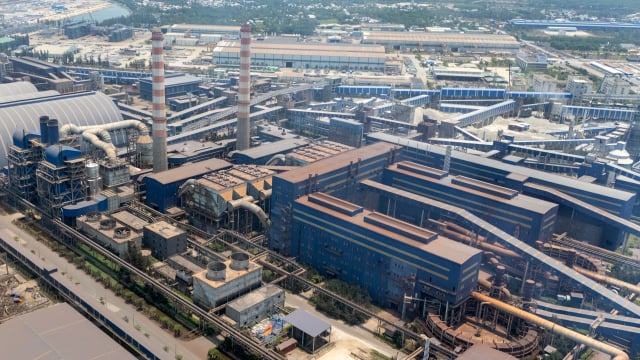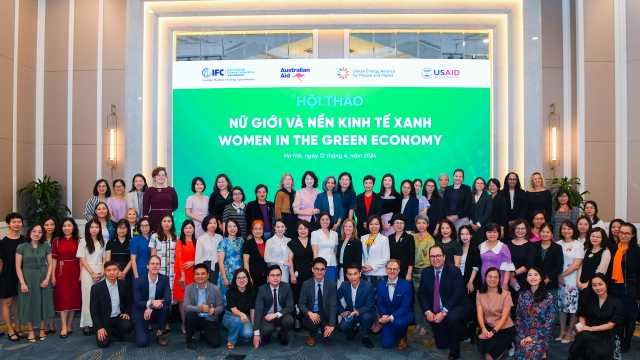National Focus
Vietnam rises to be a new manufacturing star as US-China trade war escalates
In 2019 and 2020, Vietnam will be welcoming a new wave of production and manufacturing shifting from China. Such trend will give rise to the industrial property across the nation, according to CBRE.

Vietnam has gradually built up its name on the global industrial map in recent years, thanks to its rapid developments to the national infrastructure together with its numerous trade pacts signed with major economies and regions.
The fact that higher manufacturing costs in traditional markets like China has also helped Vietnam welcome a production shift from large-scale corporations. Vietnam’s transition from peripheral to mainstream industrial nation has been seen rather swift and successful.
Leveraging on the global trade conflict as a catalyst, China’s ongoing move towards a higher income nation and the deepening ties of Vietnam into global supply chains, CBRE believes that Vietnam can sustain its new standing as Asia’s rising manufacturing economy.
The country, nevertheless, should not afford to rest on its laurels, as many nations will look to capitalise from on the disadvantages of the high labor costs in China and geopolitical tensions, CBRE stated.
Why Vietnam, why now?
China’s role in the global economy is maturing. For decades, it has served as the factory of the world. In mere two generations, China has leapfrogged from a low-income nation to a middle-income one, proving its greatest economic rise in the history.
While the transformation of such scale has been phenomenally beneficial to China, its people and its economy, the country is indeed graduating from being a manufacturing base to now relying more profoundly on service-based activities.
As a result, China has now relied less on exports. The trade dispute with the US is only speeding up this transition. China’s traditional role in global manufacturing and exports will change consequently, and its government is in fact driving this change.
It is good news for developing markets in Asia, particularly in those in Southeast Asia. Among the ASEAN nations, Vietnam is poised to be a key beneficiary and it is become an even bigger winner of the production shift from China.
There are indeed many factors supporting Vietnam’s standing in the global supply chain, with one being the production shift from China to enjoy the lower costs here.
In addition, affordable land costs are playing a part in reinforce the country’s stance, while less restrictive trade barriers, straightforward access to new supply chains, improved infrastructure, and better industrial policy supports, together with others, are ensuring a robust foundation for ongoing manufacturing success of global corporations once they move to Vietnam.
Labor costs, in particular, are a major issue for corporations when considering Vietnam as their new manufacturing hub. Annual pay of manufacturing workers in Vietnam remains relatively low in comparison to others. At roughly a third of the wage of the Chinese equivalents, local skilled manufacturing employees prove to be an advantageous alternative to those from China.
The country also has its strategic geographic position as a competitive advantage compared to its ASEAN peers like Indonesia and the Philippines.
In addition, Vietnam’s sound economic fundamentals like strong GDP growth and stable inflation rate, backed with initiatives to attract more FDI, have ideally become the key drivers to reinforce the country’s competitive position as a serious industrial player.
The government, meanwhile, continues to make heavy investments into infrastructure to build and upgrade national highways, world-class ports and better-equipped airports to support present and future industrial demands. According to Asian Development Bank (ADB) projections, Vietnam has outpaced every other Asian country, with the exception of China, on infrastructure spending as a percentage of GDP.
Friends with benefit
Above all the inner efforts and strengths, policymakers in Vietnam has long realised the importance of taking part in many bilateral and multilateral trade pacts.
In recent years, Vietnam has signed numerous bilateral and multilateral free trade agreements (FTA).
Five deals have been inked between countries in the ASEAN region with Vietnam, while six others have been initiated between ASEAN and its partners including China, South Korea, Japan, India, Australia, and New Zealand, on top of four bilateral FTA that Vietnam has secured so far.
These pacts allow the removal of duties among the member countries. To be more specific, they will help smooth the progress of setting up production base in Vietnam for foreign manufacturers. What’s more, manufacturing corporations in Vietnam will also enjoy tax benefits when they export to those markets that the country has signed the FTA with.
In order to shore up Vietnam’s economic future, investment in manufacturing and other industrial facilities has and will need to remain a priority. CBRE believes that there would be no major holdup in this commitment as the government has committed to further capitalising on Vietnam’s unique role as a viable China manufacturing alternative.
Landing on its feet
The backbone for any emerging industrial economy is the availability and functionality of the industrial real estate sector. In Vietnam, this scenario will be no different and thus rely heavily on the favorable fundamentals of the property space.
In 2019, the scale of the industrial space is swelling in Vietnam’s favour. CBRE research shows that industrial land cost in major cities across China has reached $180 per square metre. Meanwhile, in Vietnam, industrial sites are typically ranging between $100-140 per square metre. This is clearly an attractive factor for potential manufacturers.
Furthermore, the average land leasing price is increasing some 5-8 per cent in Vietnam, reflecting a rather modest price rise compared to other markets.
The availability of Vietnam’s industrial parks, especially those that have strategic locations connected to or in close proximity to key infrastructure, is on the rise.
For example, the average ready-built factory (RBF) and warehouse rental cost in Ho Chi Minh City is around $4.1 per square metre a month. On the top of the range, the highest achievable RBF rental in the southern region has reached as high as $8 per square metre a month, recorded at a new RBF site in Ho Chi Minh leased to clients from Japan.
In the northern part of the country, the average ready-built property rental price ranges from $3.5-$4 per square metre a month. The highest achievable rental price in the region, meanwhile, varies from $5.5-$6 per square metre for spaces in established industrial parks in Hanoi, Bac Ninh, Hai Duong and Haiphong.
Ahead of the curve
Going forward, CBRE said that industrial parks will continue to thrive. Occupancy rates of between 70-90 per cent will be prominent, as infrastructure connectivity will play a larger role in tenants’ rental decisions.
In a recent survey published by CBRE, the number of FDI factories in Vietnam, which named in Apple’s supplier list, has increased from 16 in 2015 to 22 in 2018.
Samsung Electronics Co., Ltd. also announced last year that it would put a stop to the operation of its mobile phone production plant in China. In Vietnam, 29 local companies have currently been Samsung’s Tier-1 suppliers. The localisation rate has jumped from 34 per cent of the total product value in 2014 to 57 per cent in 2017.
Clearly, localisation rate could speak for itself about Vietnam’s stance and its reputation as a leading location of industrial production. The good times are expected to prolong given the right governmental supports, business incentives, and corporate interest.
For the rest of 2019 and the full 2020, there would thus be an increase in industrial property supply across Vietnam to benefit from the production shifting from China, according to CBRE.
The diversification of new industrial parks, manufacturing facilities and infrastructure shows that Vietnam will enter the next decade on a firm stance and further establish itself as one of the major beneficiaries of the shifting production..
Production shift from China benefits Vietnam industrial market
Resolution 68: A turning point in Vietnam's private sector policy
As Vietnam sets its sights on becoming a high-income country by 2045, Resolution 68 lays a crucial foundation. But turning vision into reality requires not only good policy - but also unwavering execution, mutual trust and national unity.
Vietnam plans upgrade of Gia Binh airport to dual-use international hub
Vietnam plans to upgrade Gia Binh Airport in Bac Ninh province into a dual-use international airport to support both military and civilian operations, the government said on Friday.
Lives under the scorching sun: Outdoor workers racing against climate change
Under unforgiving conditions, the outdoor workers - the backbone of urban economies - endure the harshest impacts of climate change while remaining overlooked by social safety nets. Their resilience and struggles highlight the urgent need for better protection in the face of rising temperatures and precarious livelihoods.
CEO Group chairman unveils guide to Vietnam real estate for foreigners
Doan Van Binh, Chairman of CEO Group and Vice President of the Vietnam National Real Estate Association, introduced his latest book, “Vietnam Real Estate for Foreigners,” at a launch event in Hanoi on Friday.
Women leading the charge in Vietnam's green transition
Acting for increased women’s participation and leadership in climate action, Vietnam can accelerate a transition that is more inclusive, just, and impactful.
Steam for girls: A journey of passionate and creative girls
The "Steam for girls 2024" competition provides a creative platform for Steam and an opportunity for students to connect with peers from various regions within Vietnam and internationally.
























![[Hỏi đáp] Sàn thương mại điện tử nộp thuế thay: Ai là bên xuất hóa đơn?](https://t.ex-cdn.com/theleader.vn/320w/files/news/2025/12/03/ho-kinh-doanh-va-hoa-don-khi-ke-khai-1124.jpg)
![[Hỏi đáp] Doanh thu bao nhiêu được miễn thuế?](https://t.ex-cdn.com/theleader.vn/192w/files/news/2025/12/03/ke-khai-thue-ho-kinh-doanh-va-nguong-mien-thue-1723.jpg)








![[Hỏi đáp] Bỏ thuế khoán từ 2026: Hộ kinh doanh có cần thuê kế toán?](https://t.ex-cdn.com/theleader.vn/192w/files/news/2025/12/03/ho-kinh-doanh-1120.jpg)





![[Hỏi đáp] Từ thời điểm nào hộ kinh doanh không được nộp thuế khoán nữa?](https://t.ex-cdn.com/theleader.vn/192w/files/news/2025/12/03/ho-kinh-doanh-0107.jpg)
![[Hỏi đáp] Bỏ thuế khoán: Hộ kinh doanh sẽ nộp thuế như thế nào?](https://t.ex-cdn.com/theleader.vn/192w/files/news/2025/12/03/bo-thue-khoan-0116.jpg)
![[Hỏi đáp] Hộ kinh doanh bị phạt thế nào nếu kê khai sai?](https://t.ex-cdn.com/theleader.vn/192w/files/news/2025/12/03/phat-ke-khai-thue-0122.jpg)